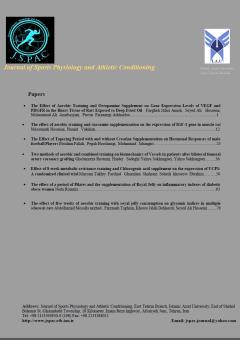-
-
List of Articles
-
Open Access Article
1 - The Effect of Aerobic Training and Octopamine Supplement on Gene Expression Levels of VEGF and PDGFR in the Heart Tissue of Rats Exposed to Deep Fried Oil
Faegheh Jafari Amoli Seyed Ali Hosseini Mohammad Ali Azarbayjani Parvin Farzanegi Arkhazloo -
Open Access Article
2 - The effect of aerobic training and curcumin supplementation on the expression of IGF-1 gene in muscle rat
Masoumeh Hosseini Hamid Vakilian -
Open Access Article
3 - The Effect of Tapering Period with and without Creatine Supplementation on Hormonal Responses of male football Players
Ebrahim Fallah Pegah Hooshangi Mohammad Jahangiri -
Open Access Article
4 - Two methods of aerobic and combined training on biomechanics of Vessels in patients after bilateral femoral artery coronary grafting
Gholamreza Rostami Haider Sadeghi Yahya Sokhanguei -
Open Access Article
5 - Effect of 8-week metabolic resistance training and Chlorogenic acid supplement on the expression of UCP1: A randomized clinical trial
Maryam Takhty Farshad Ghazalian Shahram Soheili khosrow Ebrahim -
Open Access Article
6 - The effect of a period of Pilates and the supplementation of Royal Jelly on inflammatory indexes of diabetic obese women
Neda Romuzi -
Open Access Article
7 - The effect of five weeks of aerobic training with royal jelly consumption on glycemic indices in multiple sclerosis rats
Abdolhamid Mosalla nezhad Farzaneh Taghian Khosrow Jalali Dehkordi Seyed Ali Hosseini
-
The rights to this website are owned by the Raimag Press Management System.
Copyright © 2017-2025







